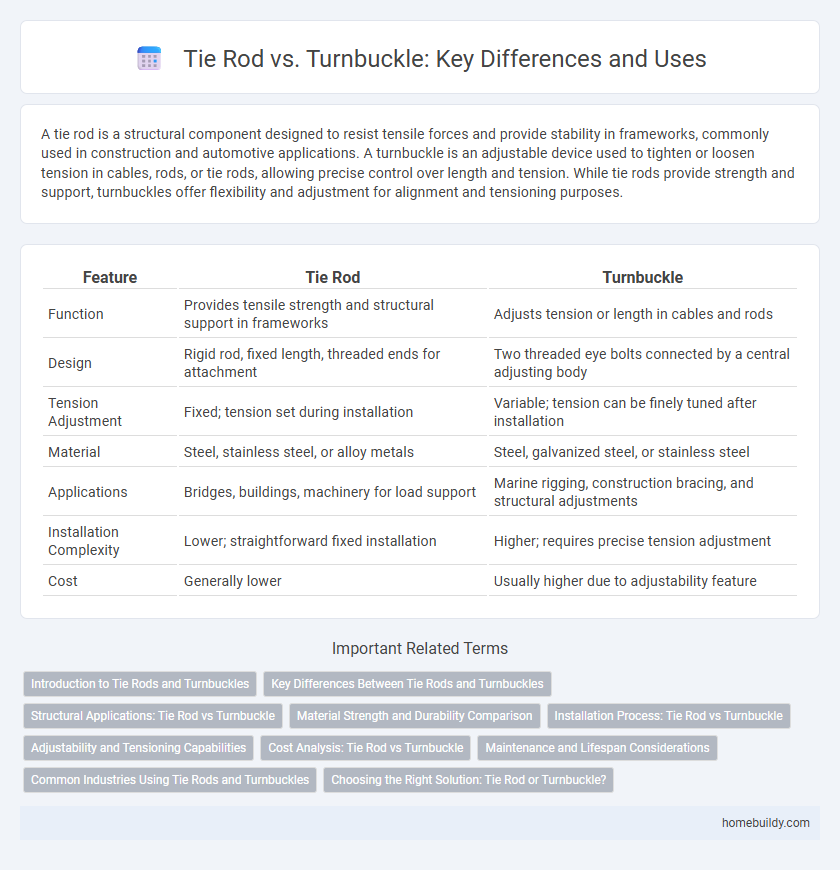A tie rod is a structural component designed to resist tensile forces and provide stability in frameworks, commonly used in construction and automotive applications. A turnbuckle is an adjustable device used to tighten or loosen tension in cables, rods, or tie rods, allowing precise control over length and tension. While tie rods provide strength and support, turnbuckles offer flexibility and adjustment for alignment and tensioning purposes.
Table of Comparison
| Feature | Tie Rod | Turnbuckle |
|---|---|---|
| Function | Provides tensile strength and structural support in frameworks | Adjusts tension or length in cables and rods |
| Design | Rigid rod, fixed length, threaded ends for attachment | Two threaded eye bolts connected by a central adjusting body |
| Tension Adjustment | Fixed; tension set during installation | Variable; tension can be finely tuned after installation |
| Material | Steel, stainless steel, or alloy metals | Steel, galvanized steel, or stainless steel |
| Applications | Bridges, buildings, machinery for load support | Marine rigging, construction bracing, and structural adjustments |
| Installation Complexity | Lower; straightforward fixed installation | Higher; requires precise tension adjustment |
| Cost | Generally lower | Usually higher due to adjustability feature |
Introduction to Tie Rods and Turnbuckles
Tie rods are rigid structural components designed to resist tension forces and maintain alignment in mechanical systems, commonly used in automotive steering and suspension assemblies. Turnbuckles serve as adjustable connectors between tie rods or cables, enabling precise tension control and length adjustments critical for ensuring proper alignment and stability. Both components play essential roles in load distribution and structural integrity, with tie rods providing strength and turnbuckles offering flexibility for fine-tuning mechanical linkages.
Key Differences Between Tie Rods and Turnbuckles
Tie rods provide rigid support by maintaining a fixed length under tensile stress, whereas turnbuckles allow fine adjustments to tension or length between connected components. Tie rods are often used in structural applications where stability is critical, while turnbuckles are ideal for achieving precise tension control in cables or rods. Material composition for tie rods typically involves high-strength steel for durability, while turnbuckles feature threaded ends enabling adjustable tightening.
Structural Applications: Tie Rod vs Turnbuckle
Tie rods provide high tensile strength and are essential in stabilizing structural frameworks by resisting tension forces in bridges, buildings, and machinery. Turnbuckles offer adjustable tensioning capabilities, allowing for precise alignment and load adjustments in structural systems. While tie rods ensure fixed, robust support, turnbuckles enable dynamic tension control, making both critical for different aspects of structural integrity.
Material Strength and Durability Comparison
Tie rods typically utilize high-strength steel alloys, offering superior tensile strength and enhanced durability under heavy loads compared to turnbuckles, which often employ softer metals or lower-grade steel. Their robust construction makes tie rods more resistant to corrosion, wear, and fatigue, especially in structural and automotive applications where long-term reliability is critical. Turnbuckles serve well for adjustable tension but generally sacrifice durability due to thinner materials and exposed threads prone to environmental damage.
Installation Process: Tie Rod vs Turnbuckle
Tie rods require precise alignment and secure fastening during installation, often involving fixed-end connections that ensure rigidity and structural integrity. Turnbuckles provide adjustable tensioning, allowing easy length modifications and fine-tuning after initial installation without disassembly. Installation of tie rods typically demands more exact measurements upfront, while turnbuckles simplify on-site adjustments through their threaded body mechanism.
Adjustability and Tensioning Capabilities
Tie rods provide fixed-length support commonly used in structural applications, offering limited adjustability once installed. Turnbuckles feature an internal screw mechanism that allows precise tensioning and length adjustment, making them ideal for applications requiring frequent or fine-tuned tension changes. The superior adjustability and tensioning capabilities of turnbuckles make them preferable for dynamic systems where load variations are common.
Cost Analysis: Tie Rod vs Turnbuckle
Tie rods generally offer a lower initial cost compared to turnbuckles, making them a budget-friendly option for structural applications. Turnbuckles, while more expensive upfront, provide adjustable tensioning capabilities that can reduce long-term maintenance expenses. Evaluating overall costs requires considering installation complexity, material durability, and specific application requirements.
Maintenance and Lifespan Considerations
Tie rods typically require less frequent maintenance due to their solid construction and fewer moving parts compared to turnbuckles, which have adjustable components prone to wear. The lifespan of a tie rod is generally longer under similar load conditions, as turnbuckles may need periodic tightening and inspection to prevent thread corrosion and mechanical failure. Proper lubrication and environmental protection extend the durability of both, but tie rods offer a more robust and low-maintenance solution for structural and mechanical applications.
Common Industries Using Tie Rods and Turnbuckles
Tie rods and turnbuckles are essential components in construction, automotive, aerospace, and marine industries for structural support and tension adjustment. Tie rods are commonly used in automotive steering systems and building frameworks where rigid support is crucial, while turnbuckles are preferred in marine rigging and industrial machinery for precise tension control. Both components ensure safety and stability across these industries by maintaining proper alignment and load distribution.
Choosing the Right Solution: Tie Rod or Turnbuckle?
Tie rods provide fixed-length support and are ideal for structural applications requiring consistent tension without adjustment. Turnbuckles offer adjustable tension, making them suitable for applications needing frequent alignment or tension changes. Choosing between tie rods and turnbuckles depends on whether rigidity or adjustability is a priority in your project.
tie rod vs turnbuckle Infographic

 homebuildy.com
homebuildy.com